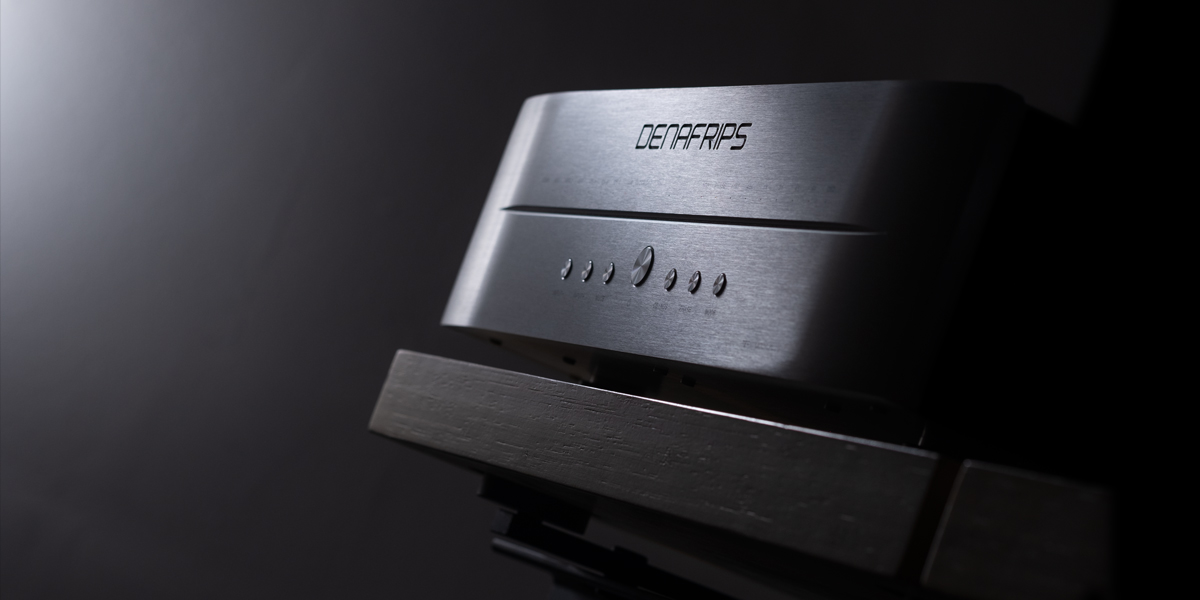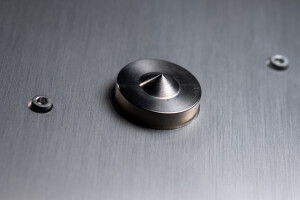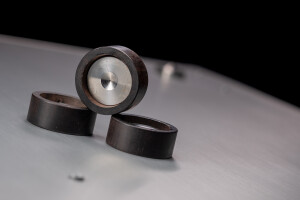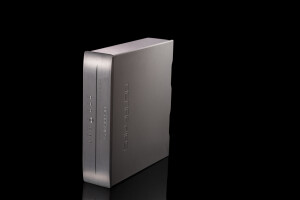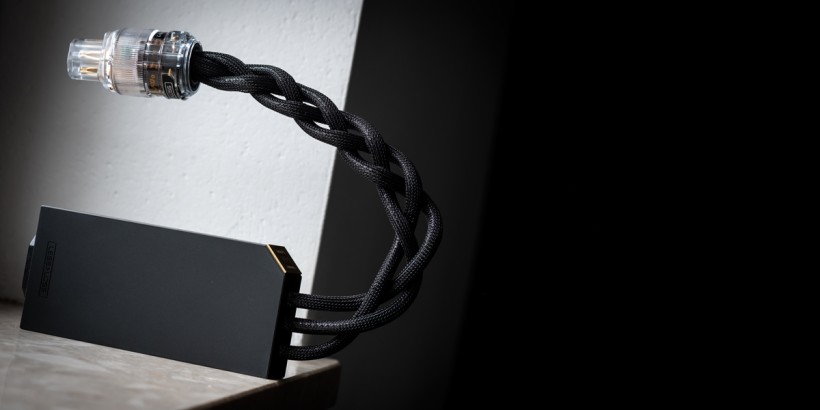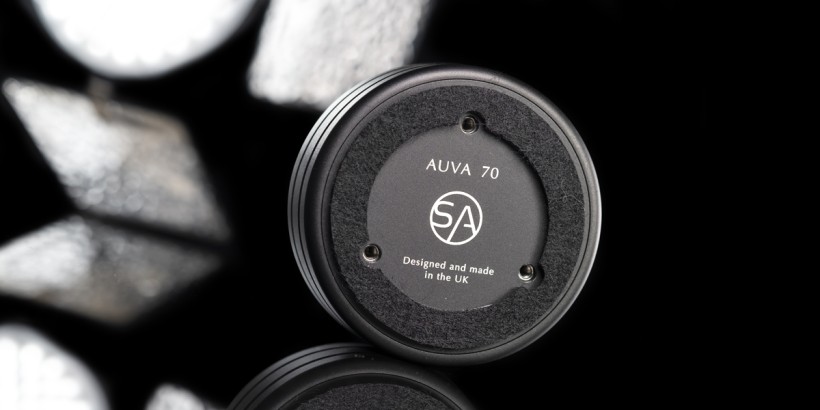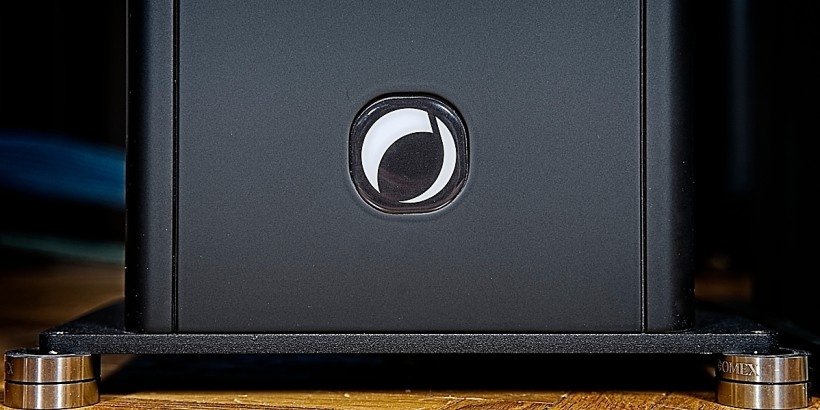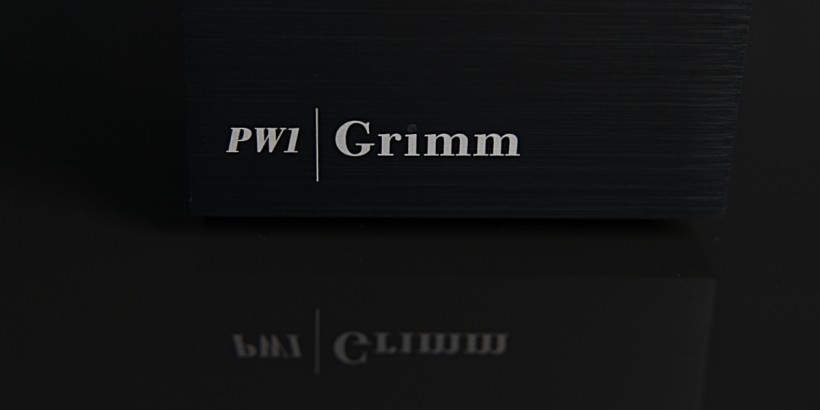In fairly short time the Chinese company Denafrips amassed lots of street cred due to its affordable ladder DACs. Just recently the opportunity to review its top model Denafrips Terminator Plus revealed itself, and now is the time to tell its story. Enjoy!
Introduction
The R2R topology is old, but clearly not outdated. Time did to this tech what it does to wine. It aged well and now is considered by many enthusiasts including yours truly as kosher and quite special. Whether a DAC has its resistor ladder matrix embedded inside a chip or fully exposed doesn’t matter to me as much as general sonics such products promise us. Over the years I’ve had the pleasure of auditioning a few and had a blast with every single one. Here I confess to my crush on R2R types. Although having one was no crime last time I checked, that feeling could potentially evolve today. This report’s Denafrips Terminator Plus is a fully-fledged ladder DAC that already generated quite the buzz and was extensively covered i.e. at Srajan’s site, but that didn’t stop me from accepting the loaner sample anyway.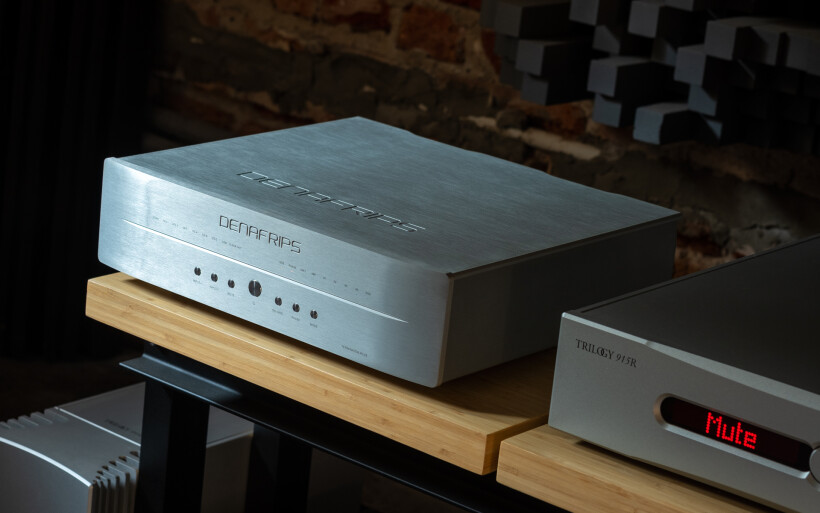 The company Denafrips is no stranger to the audio industry. It was founded in 2012 in China’s city of Guangzhou by Mr Zhao. His father and uncle were trained engineers, so surrounded by electronic components as a child he pursued the same path later on. Past graduating with a Bachelor of Electronics degree he worked for one of the largest Chinese OEM manufacturers, where for 15 years he honed his skills as a product designer. This background and massive experience gained along the way eventually resulted in Mr Zhao’s own operation that originated as a five-men effort, whose name comes from combining first letters of the following words; Dynamic, Exquisite, Natural, Attractive, Fidelity, Refined, Intoxicating, Pure and Sophisticated.
The company Denafrips is no stranger to the audio industry. It was founded in 2012 in China’s city of Guangzhou by Mr Zhao. His father and uncle were trained engineers, so surrounded by electronic components as a child he pursued the same path later on. Past graduating with a Bachelor of Electronics degree he worked for one of the largest Chinese OEM manufacturers, where for 15 years he honed his skills as a product designer. This background and massive experience gained along the way eventually resulted in Mr Zhao’s own operation that originated as a five-men effort, whose name comes from combining first letters of the following words; Dynamic, Exquisite, Natural, Attractive, Fidelity, Refined, Intoxicating, Pure and Sophisticated.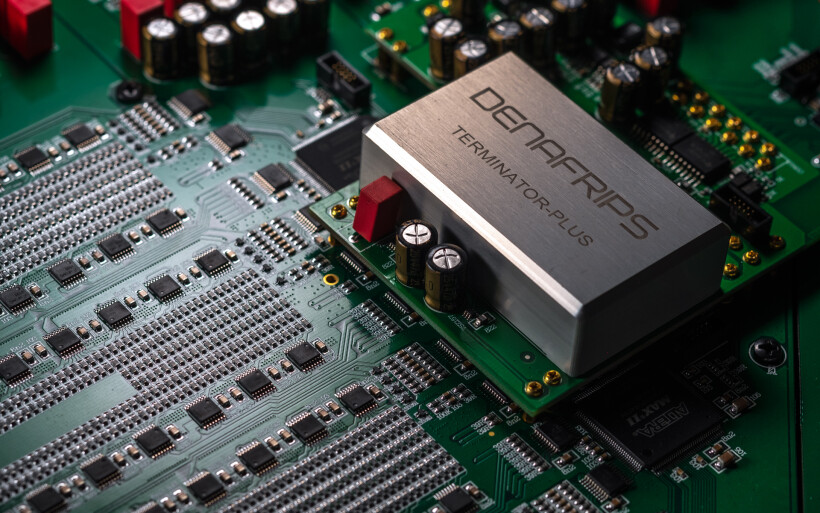 Denafrips today is a well-established business that hires 50 employees on the premises of a 15’000 square foot facility located in Guangzhou’s Panyu district, where all the R&D, assembly, QC and most manufacturing processes happen. These impressive numbers achieved within less than a decade imply expansion only a major commercial success could finance, and very aggressively priced in-house developed discrete ladder DACs are its foundation. Mr Zhao’s entry-level Ares II sells for €690 while his top dog Terminator Plus demands €5’500, which is still peanuts versus R2R hardware by the industry’s heavy hitters dCS or MSB. The way I see it, making this appealing tech accessible doesn’t change what it is. That’s why I didn’t protest when Vinshine Audio’s super-responsive Alvin Chee, who handles global sales, marketing and distribution for Denafrips, offered to send me the latter machine.
Denafrips today is a well-established business that hires 50 employees on the premises of a 15’000 square foot facility located in Guangzhou’s Panyu district, where all the R&D, assembly, QC and most manufacturing processes happen. These impressive numbers achieved within less than a decade imply expansion only a major commercial success could finance, and very aggressively priced in-house developed discrete ladder DACs are its foundation. Mr Zhao’s entry-level Ares II sells for €690 while his top dog Terminator Plus demands €5’500, which is still peanuts versus R2R hardware by the industry’s heavy hitters dCS or MSB. The way I see it, making this appealing tech accessible doesn’t change what it is. That’s why I didn’t protest when Vinshine Audio’s super-responsive Alvin Chee, who handles global sales, marketing and distribution for Denafrips, offered to send me the latter machine.
Build
A thick double cardboard housed an internal foam compartment that stored the key ingredient wrapped in a translucent bag. DACs don’t need much to get going, but this one arrived without any extras at all. No standard issue power cord, manual or RC, nada. Lack of these usual suspects is not a con to me, however. Stock AC cables are throwaways, I’m perfectly fine with manuals available online, and this report’s specimen doesn’t feature any utilities that would make a remote wand mandatory.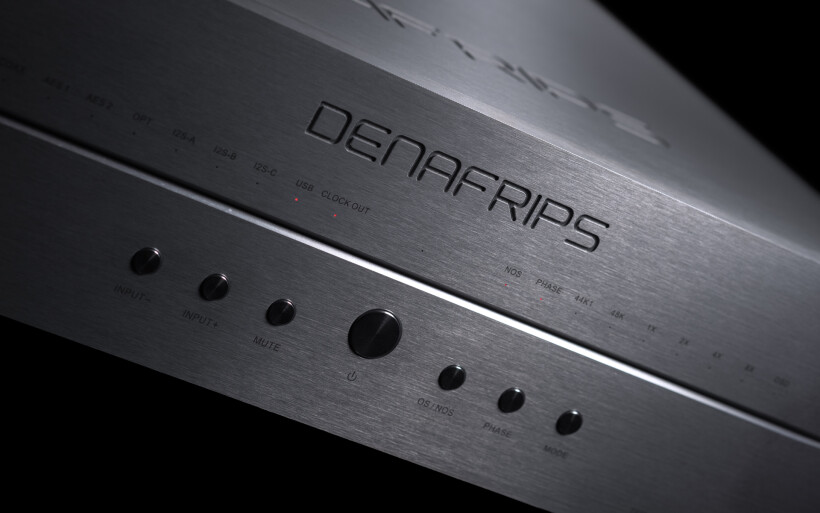 Denafrips Terminator Plus is a fully balanced purist DAC that says nay to any popular utilities beyond its core task, which means no streaming, wireless or volume control. Measurements of 430 x 380 x 105mm (W x D x H) and 19kg on the scale make this product big and heavy, albeit still fairly easily manageable by one adult. Its USB and I²S accept native DSD1024 and all digital inputs say hello to DSD64 via DoP. PCM natively goes all the way up to 1536kHz on USB and I²S, while remaining digital ports max at 24-bit/192kHz. Frequency response is 20-40KHz (-0.2dB), THD+N is 0.0010%, crosstalk is -110dB, and SNR/Dynamics are 127/>132dB respectively. Power draw is below 20W and worldwide voltages (100-240VAC, 50/60Hz) apply with no need to change voltage cards, flip switches etc. Denafrips Terminator Plus can be had in matte silver or black.
Denafrips Terminator Plus is a fully balanced purist DAC that says nay to any popular utilities beyond its core task, which means no streaming, wireless or volume control. Measurements of 430 x 380 x 105mm (W x D x H) and 19kg on the scale make this product big and heavy, albeit still fairly easily manageable by one adult. Its USB and I²S accept native DSD1024 and all digital inputs say hello to DSD64 via DoP. PCM natively goes all the way up to 1536kHz on USB and I²S, while remaining digital ports max at 24-bit/192kHz. Frequency response is 20-40KHz (-0.2dB), THD+N is 0.0010%, crosstalk is -110dB, and SNR/Dynamics are 127/>132dB respectively. Power draw is below 20W and worldwide voltages (100-240VAC, 50/60Hz) apply with no need to change voltage cards, flip switches etc. Denafrips Terminator Plus can be had in matte silver or black.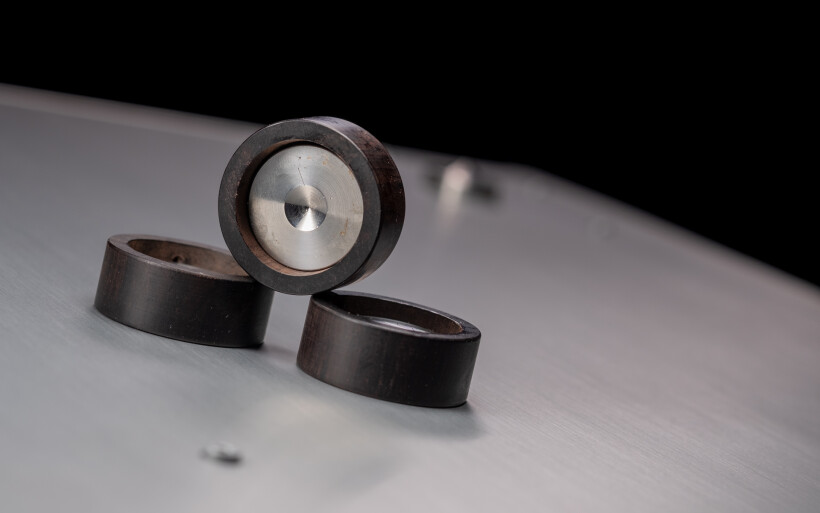 The discrete R2R architecture was Mr Zhao’s conversion method of choice due to its engineering flexibility beyond regular chips inherently limited to contents of their inside. This ladder network features multiple rows of tiny resistors, used as voltage dividers connected in parallel and series. Their sole purpose is to convert digital binary numbers into voltages proportionate to them, while bit depth determines how many are engaged. Although this brief description doesn’t suggest a job too complex, one quick glance at a regular d/a chip just next to today’s resistor matrix is all takes to see that the latter is anything but simple.
The discrete R2R architecture was Mr Zhao’s conversion method of choice due to its engineering flexibility beyond regular chips inherently limited to contents of their inside. This ladder network features multiple rows of tiny resistors, used as voltage dividers connected in parallel and series. Their sole purpose is to convert digital binary numbers into voltages proportionate to them, while bit depth determines how many are engaged. Although this brief description doesn’t suggest a job too complex, one quick glance at a regular d/a chip just next to today’s resistor matrix is all takes to see that the latter is anything but simple. Thick bushed aluminium exterior makes Denafrips Terminator Plus very robust and visually minimalist to net high compliance with its surroundings. It’s also nicely and cleverly put together, especially considering its sticker, and here I mean connective bolts hidden on its rear and underside for appealingly clean monolithic look free from any distractors. The front panel gently sloped on both sides features the manufacturer’s logo up high in the middle, while a long horizontal tapered notch separates 19 red LEDs from seven highly responsive buttons below them. These lights indicate a selected input, bond with an external clock, PCM oversampling engaged, phase reversal, 44.1/48kHz sampling rates, DSD playback and standby on/off. Pushbuttons cycle between inputs, wake up the product, enable/disable mute and oversampling, and invert phase. The one baptized ‘Mode’ via a combination of presses applies slow/sharp filter, activates dual AES/EBU inputs (one per channel) and allows for changing pinouts of I²S ports. Upon engaging the OS mode PCM streams are upsampled 2x at most but DSD always remains native.
Thick bushed aluminium exterior makes Denafrips Terminator Plus very robust and visually minimalist to net high compliance with its surroundings. It’s also nicely and cleverly put together, especially considering its sticker, and here I mean connective bolts hidden on its rear and underside for appealingly clean monolithic look free from any distractors. The front panel gently sloped on both sides features the manufacturer’s logo up high in the middle, while a long horizontal tapered notch separates 19 red LEDs from seven highly responsive buttons below them. These lights indicate a selected input, bond with an external clock, PCM oversampling engaged, phase reversal, 44.1/48kHz sampling rates, DSD playback and standby on/off. Pushbuttons cycle between inputs, wake up the product, enable/disable mute and oversampling, and invert phase. The one baptized ‘Mode’ via a combination of presses applies slow/sharp filter, activates dual AES/EBU inputs (one per channel) and allows for changing pinouts of I²S ports. Upon engaging the OS mode PCM streams are upsampled 2x at most but DSD always remains native. Each of three discs with pointy tips installed on the product’s underbelly goes into its inverted counterpart inside its own round wooden puck. The resulting hard decoupling plot doesn’t involve any springy actions and reactions. Today’s bonnet features a finely machined manufacturer’s logo and that’s it, while its rear houses one of each 2.2Vrms RCA and 4.4Vrms XLR line outputs. Their high output impedance (625/1250Ω respectively) informs us about Terminator Plus’ R2R matrix coupled directly to them. It produces signal strong enough to get by without an output stage, which means significantly shorter and simpler signal path. Moving further to the right, twin 75Ω BNCs for an external clock are followed by whooping eight digital inputs in total; coax and optical S/PDIF, dual AES/EBU, HDMI I²S, 2x RJ45 I²S and USB type B. The product’s AC inlet doesn’t feature a fuse compartment or the main on/off switch, but it’s a quality Furutech FI-06 socket not seen even in far costlier products.
Each of three discs with pointy tips installed on the product’s underbelly goes into its inverted counterpart inside its own round wooden puck. The resulting hard decoupling plot doesn’t involve any springy actions and reactions. Today’s bonnet features a finely machined manufacturer’s logo and that’s it, while its rear houses one of each 2.2Vrms RCA and 4.4Vrms XLR line outputs. Their high output impedance (625/1250Ω respectively) informs us about Terminator Plus’ R2R matrix coupled directly to them. It produces signal strong enough to get by without an output stage, which means significantly shorter and simpler signal path. Moving further to the right, twin 75Ω BNCs for an external clock are followed by whooping eight digital inputs in total; coax and optical S/PDIF, dual AES/EBU, HDMI I²S, 2x RJ45 I²S and USB type B. The product’s AC inlet doesn’t feature a fuse compartment or the main on/off switch, but it’s a quality Furutech FI-06 socket not seen even in far costlier products.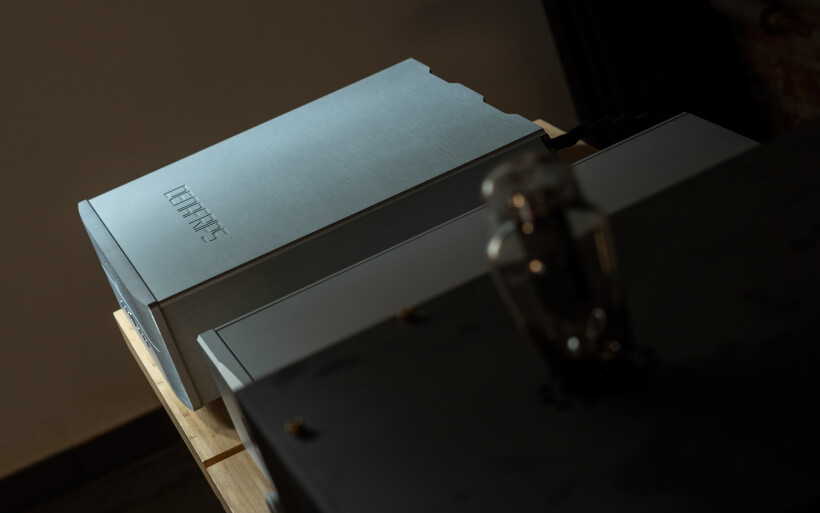 Here a word needs to be said about I²S. This interface designed to internally transmit signal between circuits separates clock and serial data, so the former doesn’t have to be recovered from it upon arrival to the receiver and that lowers jitter. Although I²S isn’t standardized, manufacturers include it in form they think is best, which is why we’ve seen it on HDMI, RJ45, BNC and S-Video. Lack of the industry’s agreement on this front also stretches to different pinouts to complicate it even more, and potentially prevent talk between a transport that sends data via I²S to a DAC. Still, many consider this bus as better on sonics versus other digital inputs. In this context today’s generous I²S socketry with changeable pins significantly reduces non-compliance with transports willing to connect accordingly and that’s a big plus. During this review I had no product at my disposal that would communicate with Terminator Plus via I²S, but something tells me that I’ve missed a lot.
Here a word needs to be said about I²S. This interface designed to internally transmit signal between circuits separates clock and serial data, so the former doesn’t have to be recovered from it upon arrival to the receiver and that lowers jitter. Although I²S isn’t standardized, manufacturers include it in form they think is best, which is why we’ve seen it on HDMI, RJ45, BNC and S-Video. Lack of the industry’s agreement on this front also stretches to different pinouts to complicate it even more, and potentially prevent talk between a transport that sends data via I²S to a DAC. Still, many consider this bus as better on sonics versus other digital inputs. In this context today’s generous I²S socketry with changeable pins significantly reduces non-compliance with transports willing to connect accordingly and that’s a big plus. During this review I had no product at my disposal that would communicate with Terminator Plus via I²S, but something tells me that I’ve missed a lot.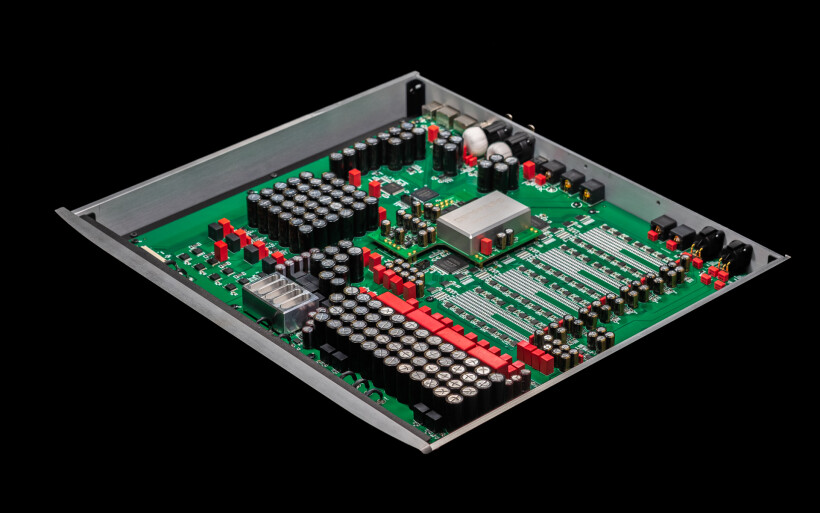 Although externally Denafrips Terminator Plus looks fairly innocent, it’s very serious on the inside. Two separate compartments one on top of the other store all its internals. The PSU on the lower floor features two massive in-house made toroidal transformers with copper shielding in-between their primary and secondary windings. This screen is grounded to shunt noise and power transients, which results in decreased noise on secondaries. Multiple 0.1F supercaps provide stable constantly cleaned DC to key circuits, while Texas Instruments ISO7241M quad-channel silicon-oxide digital isolators barrier ground and block related noise from input to output. Interestingly, Terminator Plus’ linear supply is worldwide compliant and instantly ready for action, which is typical for switching PSUs but not its type.
Although externally Denafrips Terminator Plus looks fairly innocent, it’s very serious on the inside. Two separate compartments one on top of the other store all its internals. The PSU on the lower floor features two massive in-house made toroidal transformers with copper shielding in-between their primary and secondary windings. This screen is grounded to shunt noise and power transients, which results in decreased noise on secondaries. Multiple 0.1F supercaps provide stable constantly cleaned DC to key circuits, while Texas Instruments ISO7241M quad-channel silicon-oxide digital isolators barrier ground and block related noise from input to output. Interestingly, Terminator Plus’ linear supply is worldwide compliant and instantly ready for action, which is typical for switching PSUs but not its type. The upper level houses a large PCB that looks like a single unit, but it comprises of two boards physically separated via a small gap in-between. The left side features everything DSP-related. A USB transceiver based on a STM32F446 ARM chipset with in-house developed code for it supports up to 24bit/1’536kHz and DSD1024. It activates only upon selecting USB as input, otherwise it’s off. Data from all remaining S/PDIF inputs goes directly into a FPGA logic instead of a typical receiver chip. The PCB on the right houses a fully balanced 26-bit R2R matrix with 500+ 0.005% thin-film SMD resistors and one Altera Max II FPGA logic that manages them… per channel. DSD is hardware decoded on 32-step FIR filters. The only element that connects both boards is a small tray with a large aluminium chassis where hide two oven-controlled ‘femto’ crystals that operate at 45.12/49.15MHz to target 44.1/48kHz sample rates and their multiples. These clocks powered by a separate constant-current line sit as close to the ladder network as possible to kill jitter, while a hi-speed RAM in that area buffers incoming data subject to them. All in all, Terminator Plus on the inside is nothing short of fabulous.
The upper level houses a large PCB that looks like a single unit, but it comprises of two boards physically separated via a small gap in-between. The left side features everything DSP-related. A USB transceiver based on a STM32F446 ARM chipset with in-house developed code for it supports up to 24bit/1’536kHz and DSD1024. It activates only upon selecting USB as input, otherwise it’s off. Data from all remaining S/PDIF inputs goes directly into a FPGA logic instead of a typical receiver chip. The PCB on the right houses a fully balanced 26-bit R2R matrix with 500+ 0.005% thin-film SMD resistors and one Altera Max II FPGA logic that manages them… per channel. DSD is hardware decoded on 32-step FIR filters. The only element that connects both boards is a small tray with a large aluminium chassis where hide two oven-controlled ‘femto’ crystals that operate at 45.12/49.15MHz to target 44.1/48kHz sample rates and their multiples. These clocks powered by a separate constant-current line sit as close to the ladder network as possible to kill jitter, while a hi-speed RAM in that area buffers incoming data subject to them. All in all, Terminator Plus on the inside is nothing short of fabulous.
Sound
Innuos Statement handled storage/transport, then either Denafrips Terminator Plus or LampizatOr Pacific DAC (KR Audio T-100/Living Voice 300B + KR Audio 5U4G Ltd. Ed.) passed signal to a Trilogy 915R/995R set. From there Boenicke S3 speaker cable connected either to sound|kaos Vox 3afw or Boenicke Audio W11 SE+ speakers. Interconnects used were Audiomica Laboratory Erys Excellence RCAs, Boenicke Audio IC3 CG and XLRs which I DIY-ed. All key hardware was powered by Boenicke Audio Power Gate distributor box plus its three captive M2 cords and two LessLoss C-MARCs. The USB chain included only one Mercury3.0 USB cable. A set of external LessLoss Firewall for Loudspeakers modules complimented both speaker sets, while a Fidelizer EtherStream was in-between my Linksys WRT160N router and Innuos Statement server. ISOL-8’s Prometheus PSU connected to the router and network switch.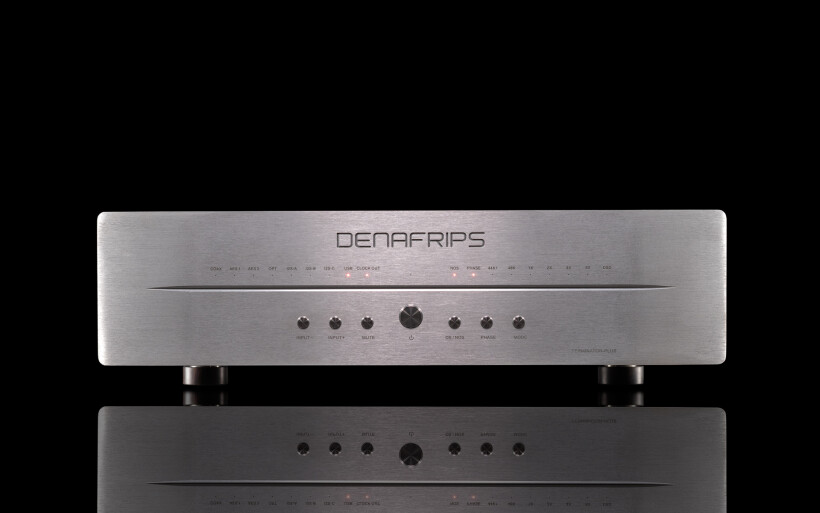 Denafrips Terminator Plus naturally had to go against Lampizator’s roughly five times dearer apex predator. Keeping their skirmish as even-handed as possible was the top priority early on, which is why both products saw my 915R’s RCA inputs and were connected to Boenicke’s power bar via two its captive power cords. One quick USB cable swap and input change on Trilogy’s preamp was all it took to engage one DAC or the other. After introductory auditions some setup adjustments had to follow. Terminator Plus passed signal to the 915R via XLRs for a balanced setup front to back, while Lampizator Pacific got far superior Boenicke IC3 CG interconnects to make up for it. This changed quite a lot as it turned out, but more on the subject later. And lastly, the former DAC had its NOS mode engaged pretty much all the time.
Denafrips Terminator Plus naturally had to go against Lampizator’s roughly five times dearer apex predator. Keeping their skirmish as even-handed as possible was the top priority early on, which is why both products saw my 915R’s RCA inputs and were connected to Boenicke’s power bar via two its captive power cords. One quick USB cable swap and input change on Trilogy’s preamp was all it took to engage one DAC or the other. After introductory auditions some setup adjustments had to follow. Terminator Plus passed signal to the 915R via XLRs for a balanced setup front to back, while Lampizator Pacific got far superior Boenicke IC3 CG interconnects to make up for it. This changed quite a lot as it turned out, but more on the subject later. And lastly, the former DAC had its NOS mode engaged pretty much all the time.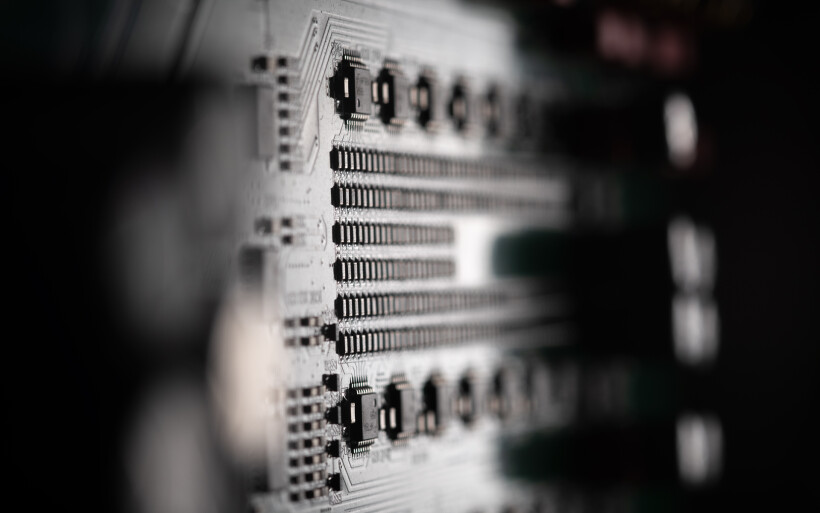 The world beyond the ΣΔ land is intriguing to say the least, and over the years I was able to familiarize myself with several its inhabitants by Chord, HifiMan, PS Audio, LessLoss, TotalDAC, AMR, Lampizator and Aqua HiFi. This list spans quite the gamut of d/a engines; from ultra-short chipless circuits and FPGAs, to R2R ladders embedded inside a chip and their naked versions as showcased in this report. My exposure to these topologies stretches across seven years give or take, so many its representatives are distant memories today. However, some specific features shared by them etched in my head well enough to raise mild expectations about each new non-ΣΔ arrival dispatched my way. Today’s subject was no different. Its innards clearly tell to which family it belongs, and grasping that it also acts accordingly didn’t take long at all.
The world beyond the ΣΔ land is intriguing to say the least, and over the years I was able to familiarize myself with several its inhabitants by Chord, HifiMan, PS Audio, LessLoss, TotalDAC, AMR, Lampizator and Aqua HiFi. This list spans quite the gamut of d/a engines; from ultra-short chipless circuits and FPGAs, to R2R ladders embedded inside a chip and their naked versions as showcased in this report. My exposure to these topologies stretches across seven years give or take, so many its representatives are distant memories today. However, some specific features shared by them etched in my head well enough to raise mild expectations about each new non-ΣΔ arrival dispatched my way. Today’s subject was no different. Its innards clearly tell to which family it belongs, and grasping that it also acts accordingly didn’t take long at all.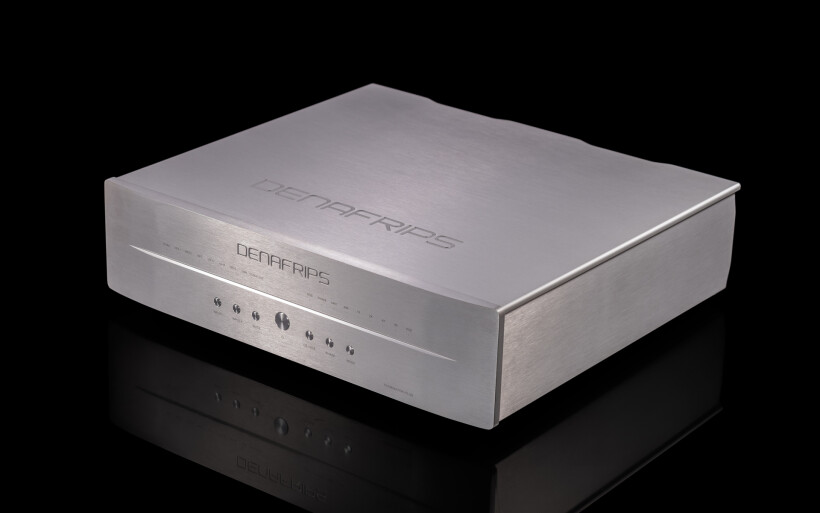 Various d/a conversion methods mentioned above had in common a particular sort of maturity and seasoning useful in keeping at bay any aural aggression that eventually introduces fatigue. If pushed too hard, sound primarily focused on detail retrieval, spaciousness and quickness also becomes piercing, itchy, sharp, skinny, hollow, ethereal and dry, and naturally comes at a price paid in color, density, vividness and the lot. Although such chiseled flashy voicing might introduce the early ‘wow’ sensation, without properly developed muscular tissue and roundness here and there it doesn’t hold its ground in the long run. Having said that, R2R machines I’d heard in the past excelled on fine tonal structures, smoothness and specific kind of organic texturing typical just for them. Although more dark, earthy and moist than glossy, lit-up and angelic, they also scored very high on detailing, background blackness, propulsion, effortlessness and ability to render music in posh enchanting fashion as far from tiresome as it gets. Denafrips Terminator Plus not only fits that profile to perfection, but on several counts it also went a fair bit further than any similar specimen I recall, to eventually flourish into a wonderfully complex and thoroughly sorted performer clearly way above its sticker.
Various d/a conversion methods mentioned above had in common a particular sort of maturity and seasoning useful in keeping at bay any aural aggression that eventually introduces fatigue. If pushed too hard, sound primarily focused on detail retrieval, spaciousness and quickness also becomes piercing, itchy, sharp, skinny, hollow, ethereal and dry, and naturally comes at a price paid in color, density, vividness and the lot. Although such chiseled flashy voicing might introduce the early ‘wow’ sensation, without properly developed muscular tissue and roundness here and there it doesn’t hold its ground in the long run. Having said that, R2R machines I’d heard in the past excelled on fine tonal structures, smoothness and specific kind of organic texturing typical just for them. Although more dark, earthy and moist than glossy, lit-up and angelic, they also scored very high on detailing, background blackness, propulsion, effortlessness and ability to render music in posh enchanting fashion as far from tiresome as it gets. Denafrips Terminator Plus not only fits that profile to perfection, but on several counts it also went a fair bit further than any similar specimen I recall, to eventually flourish into a wonderfully complex and thoroughly sorted performer clearly way above its sticker.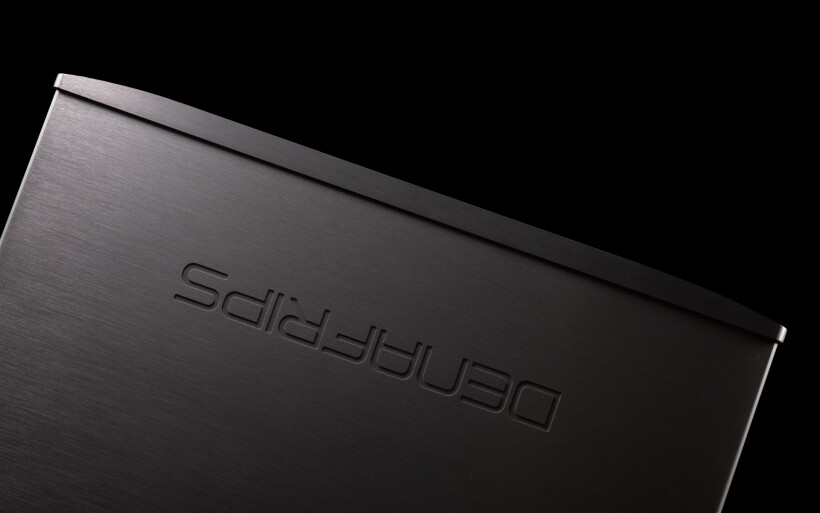 Prior to going any further let me explain the definition of the word ‘organic’ in my privy glossary. It describes a specific type of tissue on sound sources that boosts their mass, injects extra color and provides roundness, but in such a clever way to have them as pleasantly elastic and lively as they’re substantial, hydrated and present. Here one could think about warmth, but that implies thick syrupy frosting which limits speed and clarity, sucks out oxygen and possibly kills tiny dust bits floating in air. In this context the organic flavor is inherently somewhat thick, but also more fragrant, zesty, moist and elaborate than bluntly sweet and chunky. To simplify, imagine sonic warmth yet more composite, leaner, outlined and free from the usual drawbacks. Today’s hero had plenty of that, which in fact emerged as one of its most prominent traits.
Prior to going any further let me explain the definition of the word ‘organic’ in my privy glossary. It describes a specific type of tissue on sound sources that boosts their mass, injects extra color and provides roundness, but in such a clever way to have them as pleasantly elastic and lively as they’re substantial, hydrated and present. Here one could think about warmth, but that implies thick syrupy frosting which limits speed and clarity, sucks out oxygen and possibly kills tiny dust bits floating in air. In this context the organic flavor is inherently somewhat thick, but also more fragrant, zesty, moist and elaborate than bluntly sweet and chunky. To simplify, imagine sonic warmth yet more composite, leaner, outlined and free from the usual drawbacks. Today’s hero had plenty of that, which in fact emerged as one of its most prominent traits. I’m aware of no zippy articulate open DAC that would be as equally gifted on density, color and expressiveness, and Terminator Plus with its own strongly pronounced personality isn’t one either. Naming it as somewhat warm, dense and soft is no crime in the grand scheme, but that brief psych profile dearly misses the big picture. How the Chinese loaner managed to cover all remaining bases on top of its core voice and against my reference is key. Most listeners would agree that their fight narrowed down to two very different sonic aesthetics more than anything else. It’s not the first time when that happened and explaining where Terminator Plus positioned itself against its sparring partner is easy, but the major if not a bit personal clincher was elsewhere. Withdrawal symptoms past disengaging my daily driver were just a matter of time until now, but the quite oppositely geared Terminator Plus was no mere short-term substitute drug. It truly had what it takes to keep the usual craves at the door and properly contest Pacific’s position under my roof. Just to be clear, no other DAC managed to do this.
I’m aware of no zippy articulate open DAC that would be as equally gifted on density, color and expressiveness, and Terminator Plus with its own strongly pronounced personality isn’t one either. Naming it as somewhat warm, dense and soft is no crime in the grand scheme, but that brief psych profile dearly misses the big picture. How the Chinese loaner managed to cover all remaining bases on top of its core voice and against my reference is key. Most listeners would agree that their fight narrowed down to two very different sonic aesthetics more than anything else. It’s not the first time when that happened and explaining where Terminator Plus positioned itself against its sparring partner is easy, but the major if not a bit personal clincher was elsewhere. Withdrawal symptoms past disengaging my daily driver were just a matter of time until now, but the quite oppositely geared Terminator Plus was no mere short-term substitute drug. It truly had what it takes to keep the usual craves at the door and properly contest Pacific’s position under my roof. Just to be clear, no other DAC managed to do this.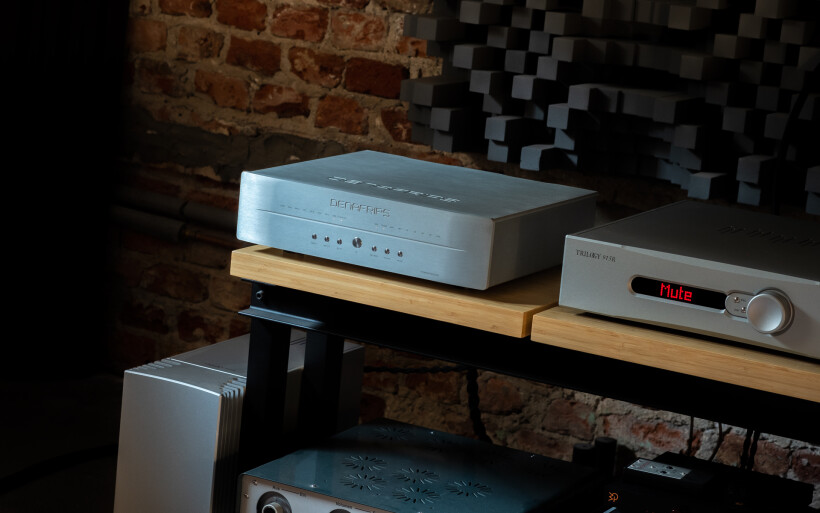 KR Audio’s 5U4G rectifier and Kevin Scott’s 300B glass make my reference DAC exceptionally resolving, open, immediate, powerful and outlined. This lean sporty behavior clearly aspirated for adrenaline also cuts distance to closest sound sources, rendered as large shapes inside a generously oxygenated brilliantly developed sphere. The resulting here and now direct presentation works particularly awesome with live recordings, and demands fastening seatbelts at high SPL. DHTs used as buffers at Pacific’s output stage balance its naturally sunny zealous disposition by admirably layered textures, wide color range, smoothness and everything else that makes music enjoyable and spot on weighty. This DAC knows when to morph into soothing, inviting, polite, pretty, atmospheric or plainly haunting specimen, but its unforgiving nature calls for quality music to work on. Needless to say, as a full-time audio reporter I find that trait quite useful now.
KR Audio’s 5U4G rectifier and Kevin Scott’s 300B glass make my reference DAC exceptionally resolving, open, immediate, powerful and outlined. This lean sporty behavior clearly aspirated for adrenaline also cuts distance to closest sound sources, rendered as large shapes inside a generously oxygenated brilliantly developed sphere. The resulting here and now direct presentation works particularly awesome with live recordings, and demands fastening seatbelts at high SPL. DHTs used as buffers at Pacific’s output stage balance its naturally sunny zealous disposition by admirably layered textures, wide color range, smoothness and everything else that makes music enjoyable and spot on weighty. This DAC knows when to morph into soothing, inviting, polite, pretty, atmospheric or plainly haunting specimen, but its unforgiving nature calls for quality music to work on. Needless to say, as a full-time audio reporter I find that trait quite useful now.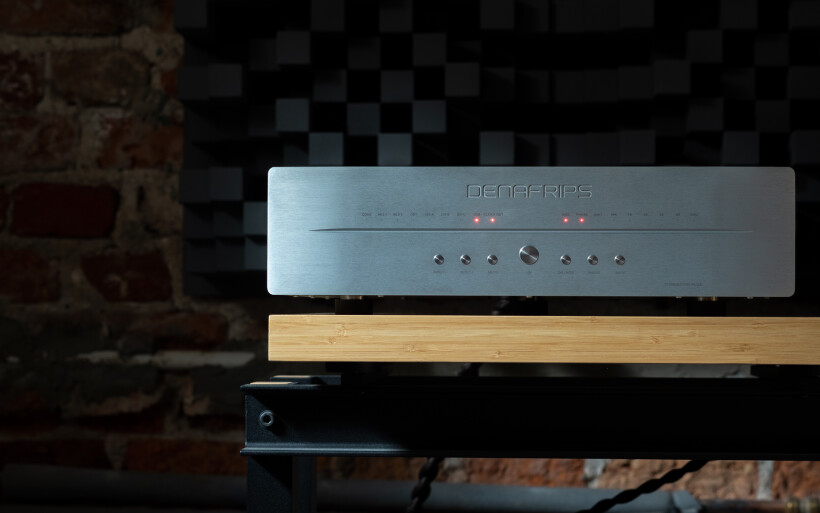 Denafrips Terminator Plus being the more distant and denser of the two shouldn’t be any surprise by now. Its emphasis on color, heft, and thicker frames naturally translated into somewhat mellow, soft and dreamy approach that normally should net fewer points on articulation and clarity, but that wasn’t the case. Most ladder DACs I’d heard were well sorted on these fronts and so was today’s machine. That’s why its audibly less direct, shimmery and electric profile versus my reference was no drawback but manifestation of its distinctively different personality. Although Terminator Plus had my attention primarily locked on tonal qualities and particularly fetching atmospheric vibe only its kind knows how to pull off, it didn’t feel truncated on details, spatially any smaller or less developed. That’s the exact reason why shifts from Pacific to this machine weren’t painful at all.
Denafrips Terminator Plus being the more distant and denser of the two shouldn’t be any surprise by now. Its emphasis on color, heft, and thicker frames naturally translated into somewhat mellow, soft and dreamy approach that normally should net fewer points on articulation and clarity, but that wasn’t the case. Most ladder DACs I’d heard were well sorted on these fronts and so was today’s machine. That’s why its audibly less direct, shimmery and electric profile versus my reference was no drawback but manifestation of its distinctively different personality. Although Terminator Plus had my attention primarily locked on tonal qualities and particularly fetching atmospheric vibe only its kind knows how to pull off, it didn’t feel truncated on details, spatially any smaller or less developed. That’s the exact reason why shifts from Pacific to this machine weren’t painful at all. Here I could further deconstruct each DAC’s voicing into finer bits, but their fight truly wasn’t a matter of this or that trait developed more or less. Suffice it to say, Terminator Plus provided insight on top of its inherently firm grounded backbone, while Pacific’s own investigative supple spine came before its muscle mass, but both these products felt equally accomplished. The decision which one to engage was solely related to my mood and repertoire of choice, so purely subjective things. Explosive jabs, high contrast ratio, pleasant brutality and rawness served up close and personal called for Lampizator’s deck, while larger fuller blows, higher expression and atmospheric picturesque landscapes steered me towards Terminator Plus. Both products also clocked roughly the same amount of time, which I believe is quite self-explanatory given their respective price tags.
Here I could further deconstruct each DAC’s voicing into finer bits, but their fight truly wasn’t a matter of this or that trait developed more or less. Suffice it to say, Terminator Plus provided insight on top of its inherently firm grounded backbone, while Pacific’s own investigative supple spine came before its muscle mass, but both these products felt equally accomplished. The decision which one to engage was solely related to my mood and repertoire of choice, so purely subjective things. Explosive jabs, high contrast ratio, pleasant brutality and rawness served up close and personal called for Lampizator’s deck, while larger fuller blows, higher expression and atmospheric picturesque landscapes steered me towards Terminator Plus. Both products also clocked roughly the same amount of time, which I believe is quite self-explanatory given their respective price tags.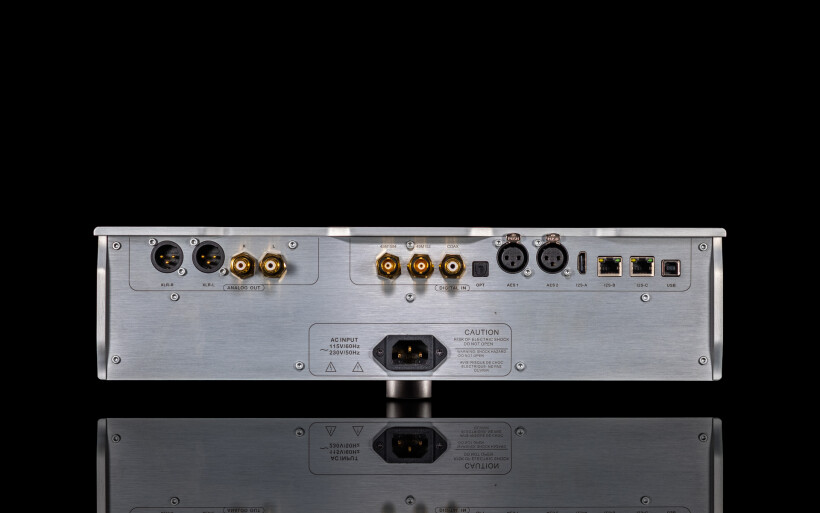 Terminator Plus auditioned as a single-ended device already struck me as a wonderfully voiced kit, just to noticeably grow from there upon sending signal from its XLR outs to the 915R’s corresponding inputs. Here I had no clue which balanced circuit contributed more and in what way exactly, but that was of no importance, on the contrary to how much untapped performance reserve there still was. My setup with Denafrips’ DAC used as described was noticeably more oxygenated, rapid and wilder, but at no quality loss anywhere else to indicate sheer gains and rarely heard aural wholeness. This a touch romantic profile didn’t transform into something it wasn’t in the first place, though. Terminator Plus still had its delicate silken gloves on with all associated traits, but now slammed like a monster to move more air more easily than before, pack sensibly harder punches and remain very meticulous whilst doing so. Prior to swapping its outputs I already rated this DAC very high, but past triangulations in a fully balanced rig it jumped up a bracket, to effectively secure more usage time than its rival with two quick open Swiss speakers I had available.
Terminator Plus auditioned as a single-ended device already struck me as a wonderfully voiced kit, just to noticeably grow from there upon sending signal from its XLR outs to the 915R’s corresponding inputs. Here I had no clue which balanced circuit contributed more and in what way exactly, but that was of no importance, on the contrary to how much untapped performance reserve there still was. My setup with Denafrips’ DAC used as described was noticeably more oxygenated, rapid and wilder, but at no quality loss anywhere else to indicate sheer gains and rarely heard aural wholeness. This a touch romantic profile didn’t transform into something it wasn’t in the first place, though. Terminator Plus still had its delicate silken gloves on with all associated traits, but now slammed like a monster to move more air more easily than before, pack sensibly harder punches and remain very meticulous whilst doing so. Prior to swapping its outputs I already rated this DAC very high, but past triangulations in a fully balanced rig it jumped up a bracket, to effectively secure more usage time than its rival with two quick open Swiss speakers I had available.
Summary
A month spent with Denafrips Terminator Plus was enough to understand that we’d see several times as much on its tag if it were dressed fancier somewhere in Europe with according logo on its forehead or bonnet. Yes, it is an overachiever this massive, but Chinese origin and price to sell don’t make it any less real. If I were after a DAC now, I would look no further considering what this one does.
Visually modest aluminium exterior makes Denafrips Terminator Plus a no-frills DAC built like a tank and commensurably heavy at that. It operates flawlessly, runs barely warm and its generous i/o with user-configurable I²S ports and inputs for external clocks should make even the most demanding consumers more than happy. Proper decoupling footers, Furutech’s IEC inlet, no bolts anywhere in sight and evenly mounted buttons imply attention to details far dearer products wouldn’t be ashamed of. Today’s innards however would make many blush and look like toys in comparison, and even more so considering sonics its in-house developed circuit managed to pull. Denafrips Terminator Plus is nothing short of a tremendous bargain and quite the troublemaker truly fit to go against most DACs out there.
As far as sheer sonic excellence and completeness go, today’s hero positioned itself somewhere in the ballpark of my reference DAC. Their opposite profiles, topological differences and utilities aside, that’s just the place where the former also belongs… and I haven’t even touched its I²S inputs. If that’s too good to be true and there has to be a catch somewhere, well, I don’t think there is one. Every so often a major disruptor is bound to happen, and Denafrips Terminator Plus simply has what it takes to be one indeed. ‘Til next time!
Associated Equipment:
- Amplifier: Trilogy 995R
- DAC: LampizatOr Pacific (KR Audio T-100 / Living Voice 300B + KR Audio 5U4G Ltd. Ed.)
- Speakers: Boenicke Audio W11 SE+, sound|kaos Vox 3afw
- Transport: Innuos Statement
- Preamplifier: Trilogy 915R
- Speaker cables: Boenicke Audio S3, LessLoss C-MARC
- Speaker signal conditioning: LessLoss Firewall for Loudspeakers
- Interconnects: Boenicke Audio IC3 CG
- Power components: Gigawatt PC-3 SE EVO+/LC-3 EVO, LessLoss C-MARC, Boenicke Audio Power Gate, iFi audio PowerStation, ISOL-8 Prometheus
- USB components: iFi audio Mercury3.0
- Rack: Franc Audio Accesories Wood Block Rack
- Network: Fidelizer EtherStream, Linksys WRT160N
- Music: NativeDSD
Retail prices of reviewed components in EU (incl. tax):
- Denafrips Terminator Plus: €5’550
Manufacturer: Vinshine Audio



